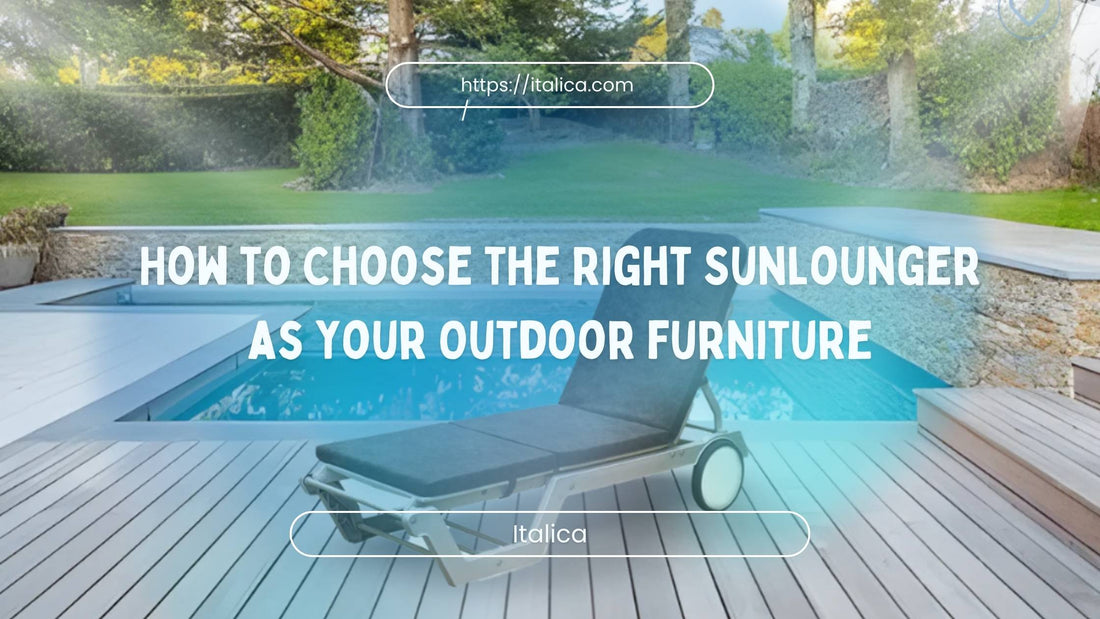
How to Choose the Right Sunlounger as Your Outdoor Furniture
Share
Why You Should Read This
Most people waste money on outdoor furniture that looks good but doesn’t last. A bad choice means cracked frames, fading color, or loungers too heavy to move. This guide will save you from those mistakes. You’ll learn how to pick a plastic sunlounger that delivers comfort, style, and durability—without burning your budget.
What We’ll Cover
Here’s the 80/20 of what you need:
- Material matters – why plastic wins outdoors.
- Comfort features – what actually makes a lounger worth using.
- Durability and maintenance – how to make it last years, not months.
- Design and style – matching your outdoor vibe.
- Size and portability – making sure it fits your space.
- Value for money – how to get quality without overspending.
- Follow these six steps, and you’ll cover 80% of what drives the right choice.
Real-Life Stories
Case 1: The Poolside Upgrade
Ravi had a poolside deck but no real seating. He tried wooden loungers first. Within two monsoons, they swelled, cracked, and looked worn. He switched to Italica plastic sunloungers. They handled rain, chlorine splashes, and direct sun without warping. Now, he only wipes them down once a week, and they still look brand new.
Lesson: If you live in a humid or rainy climate, plastic beats wood every time.
Case 2: The Garden Retreat
Anita wanted a peaceful reading corner in her garden. She bought a heavy metal lounger on sale. It looked sleek but rusted after one season. Plus, it was too heavy to move when she wanted shade. She swapped it for a lightweight plastic sunlounger. Now, she shifts it easily under the tree or into the sun, depending on her mood.
Lesson: If you want flexibility, choose lightweight plastic over metal.
Case 3: The Airbnb Host
Sameer runs a beachside Airbnb. Guests complained about flimsy chairs that broke under weight. He invested in ergonomically designed plastic loungers from Italica. They support different body types, are UV-resistant, and stack easily when he needs space. Reviews went up, and bookings followed.
Lesson: For rentals or commercial use, plastic loungers give the best ROI.
Testimonials
-
“We replaced all our wooden loungers with Italica plastic sunloungers last summer. Zero maintenance, and guests love them.” – Nisha, Resort Owner
-
“I use mine daily by the pool. The adjustable backrest makes it perfect for both sunbathing and reading. Worth every rupee.” – Arjun, Homeowner
-
“I needed something stylish but practical for my café garden. These loungers fit perfectly, and they’re so easy to clean.” – Ritu, Café Owner
How to Choose the Right Plastic Sunlounger
1. Pick the Right Material
Most sunloungers come in wood, metal, or plastic. Here’s the breakdown:
- Wood: Stylish but high maintenance. Needs sealing, cracks with weather.
- Metal: Looks premium but rusts fast outdoors. Heavy to move.
- Plastic: Lightweight, weather-proof, low maintenance, and affordable.
Action: If you want longevity with low effort, go plastic.
2. Comfort Features
A lounger is only useful if it’s comfortable. Look for:
- Adjustable backrest: Lets you sit upright to read or lie flat to nap.
- Ergonomic design: Supports natural body curves.
- Armrests: Optional, but nice for long reading sessions.
- Cushion option: Some models allow add-on cushions for extra comfort.
Action: Test the backrest adjustment before buying.
3. Durability and Maintenance
Outdoor furniture battles sun, rain, and dust. Plastic loungers—especially from Italica—are:
- UV-resistant (won’t fade in sun).
- Water-resistant (no swelling like wood).
- Rust-proof (unlike metal).
Cleaning is simple: a damp cloth or mild soap wash.
Action: Choose UV-stabilized plastic to avoid color fading.
4. Design and Style
Your lounger should match your outdoor vibe. Options include:
- Minimalist white or grey – clean, modern look.
- Earth tones – blend with garden spaces.
- Bold colors – perfect for poolside energy.
Italica offers multiple shades, so you don’t need to compromise style for function.
Action: Match the lounger color with your existing outdoor furniture.
5. Size and Portability
Space matters. Ask yourself:
- Do you need stackable loungers for easy storage?
- Do you want foldable loungers for portability?
- Will standard size fit your deck, or do you need compact options?
Plastic loungers are lighter, so you can move them around without hassle.
Action: Measure your space before buying. A common mistake is buying too many or oversized loungers.
6. Affordability and Value
Don’t confuse cheap with value. A low-price lounger that cracks in a year costs more long term. Italica loungers hit the sweet spot—affordable upfront and long-lasting.
Action: Calculate cost per year, not just cost per piece. A quality plastic sunlounger often lasts 5–7 years.
Conclusion
A sunlounger isn’t just furniture. It’s your outdoor relaxation tool. Get the material right, prioritize comfort, and make sure it’s built to last.
If you want the 80/20 pick, choose a plastic sunlounger. It balances durability, portability, and price better than wood or metal. Italica’s range stands out because it’s ergonomic, UV-proof, and stylish.
Whether you’re hosting guests, running a business, or just creating your own oasis, the right sunlounger turns your outdoor space into a daily retreat.
Final Action Step:
Before buying, make a quick checklist:
- Material: Plastic ✔
- Comfort: Adjustable backrest ✔
- Durability: UV + water-resistant ✔
- Design: Matches your style ✔
- Portability: Lightweight or stackable ✔
- Value: Lasts at least 5 years ✔
If it checks these boxes, you’ve found your sunlounger.






